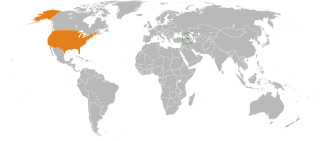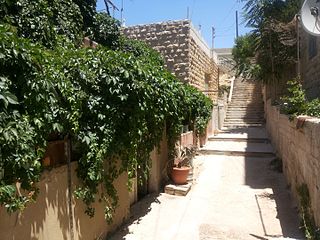The Armenian Professional Society is an organization that aims to better "fellowship among Armenian professionals", created in 1958. Membership requirements include a four-year degree from an accredited university and being sponsored by two paying members of APS.

Armenian is an Indo-European language belonging to an independent branch of which it is the only member. It is the official language of Armenia. Historically spoken in the Armenian Highlands, today Armenian is widely spoken throughout the Armenian diaspora. Armenian is written in its own writing system, the Armenian alphabet, introduced in 405 AD by the priest Mesrop Mashtots. The total number of Armenian speakers worldwide is estimated between 5 and 7 million.

The Armenian genocide was the systematic mass murder and ethnic cleansing of around one million ethnic Armenians from Anatolia and adjoining regions by the Ottoman Empire and its ruling party, the Committee of Union and Progress (CUP), during World War I.
Reuben is a Biblical male first name:

Armenians are an ethnic group native to the Armenian Highlands of Western Asia.

Sargis Sargsian is a former professional tennis player from Armenia.

The Mkhitar Heratsi Yerevan State Medical University, is the leading Armenian medical university located in Yerevan, Armenia.
Armenian Americans are citizens or residents of the United States who have total or partial Armenian ancestry. They form the second largest community of the Armenian diaspora after Armenians in Russia. The first major wave of Armenian immigration to the United States took place in the late 19th and early 20th centuries. Thousands of Armenians settled in the United States following the Hamidian massacres of the mid-1890s, the Adana Massacre of 1909, and the Armenian genocide of 1915-1918 in the Ottoman Empire. Since the 1950s many Armenians from the Middle East migrated to America as a result of political instability in the region. It accelerated in the late 1980s and has continued after the dissolution of the Soviet Union in 1991 due to socio-economic and political reasons.
The Armenian calendar is the calendar traditionally used in Armenia.

Armenian genocide denial is the claim that the Ottoman Empire and its ruling party, the Committee of Union and Progress (CUP), did not commit genocide against its Armenian citizens during World War I—a crime documented in a large body of evidence and affirmed by the vast majority of scholars. The perpetrators denied the genocide as they carried it out, claiming Armenians were resettled for military reasons, not exterminated. In the genocide's aftermath incriminating documents were systematically destroyed, and denial has been the policy of every government of the Republic of Turkey as of 2021.

Karabakh is a geographic region in present-day southwestern Azerbaijan and eastern Armenia, extending from the highlands of the Lesser Caucasus down to the lowlands between the rivers Kura and Aras.

Armenian Argentines are ethnic Armenians who live in Argentina. Estimates vary, but between 70 and 120 thousand people of Armenian ancestry live in the country, forming one of the largest groups in the Armenian diaspora worldwide. The core of the population came from Cilicia, Syria and Lebanon. In Buenos Aires, the Armenian community is known to share their common culture with the Basque community through musical events and cultural activities.

Armenia, officially the Republic of Armenia, is a landlocked country located in the Armenian Highlands of Western Asia. It is a part of the Caucasus region; and is bordered by Turkey to the west, Georgia to the north, the Lachin corridor under a Russian peacekeeping force, and Azerbaijan to the east, and Iran and the Azerbaijani exclave of Nakhchivan to the south.
Tekeyan Cultural Association Arshag Dickranian Armenian School was a private K-12 Armenian school in Hollywood, Los Angeles, California.
Football is the most popular sport in Armenia.

Armenia–United States relations refers to bilateral relations between Armenia and the United States of America. The dissolution of the Soviet Union in December 1991 brought an end to the Cold War and created the opportunity for bilateral relations with the New Independent States (NIS) as they began a political and economic transformation. The United States recognized the independence of Armenia on December 25, 1991, and opened an embassy in the capital city of Armenia, Yerevan in February 1992.

Armenians in Jordan are ethnic Armenians living within the current Hashemite Kingdom of Jordan. There are an estimated 3,000 Armenians living in the country today with an estimated 2,500 of them being members of the Armenian Apostolic Church, and predominantly speak Western Armenian dialect. Armenians make up the biggest majority of non-Arab Christians in the country.

Agricultural Engineering is the field of study and application of engineering science and designs principles for agriculture purposes, combining the various disciplines of mechanical, civil, electrical, food science, environmental, software, and chemical engineering to improve the efficiency of farms and agribusiness enterprises as well as to ensure sustainability of natural and renewable resources.

Women in Armenia have enjoyed equal rights, including the right to vote, since the establishment of the First Republic of Armenia. On June 21 and 23, 1919, the first direct parliamentary elections were held in Armenia under universal suffrage - every person over the age of 20 had the right to vote regardless of gender, ethnicity or religious beliefs. The 80-seat legislature, charged with setting the foundation for an Armenian state, contained three women deputies: Katarine Zalyan-Manukyan, Perchuhi Partizpanyan-Barseghyan and Varvara Sahakyan.
The COVID-19 pandemic in Armenia is part of the worldwide pandemic of coronavirus disease 2019 caused by severe acute respiratory syndrome coronavirus 2. The virus was confirmed to have reached Armenia on 1 March 2020 when its first case was reported. It has spread to all of the regions (marz) of Armenia and has caused 4,400 deaths.